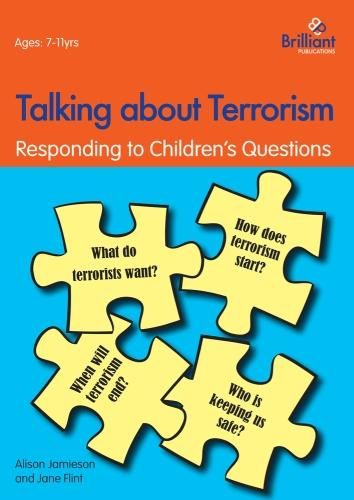Readings Newsletter
Become a Readings Member to make your shopping experience even easier.
Sign in or sign up for free!
You’re not far away from qualifying for FREE standard shipping within Australia
You’ve qualified for FREE standard shipping within Australia
The cart is loading…






This title is printed to order. This book may have been self-published. If so, we cannot guarantee the quality of the content. In the main most books will have gone through the editing process however some may not. We therefore suggest that you be aware of this before ordering this book. If in doubt check either the author or publisher’s details as we are unable to accept any returns unless they are faulty. Please contact us if you have any questions.
Children’s questions about terrorism can be penetrating and hard to answer. Why do they hate us? How does someone become a terrorist? Will they plant bombs in our city? many teachers (and parents) will be caught unawares by such questions, uncertain themselves about terrorist motivation and goals and torn between the natural instinct to reassure and the awareness that Britain is on continuous terrorist alert.
Since the attacks in Tunisia, Paris and Brussels, and with regular news headlines about teenagers leaving Britain to join ISIS, children as young as 7 are aware of terrorism. They have questions to which they expect answers, and teachers need resources to help them respond.
The Prevent strategy urges schools to create ‘safe spaces’ for the discussion of controversial issues. With Ofsted inspections evaluating their efforts in this regard, primary schools are being placed under increasing pressure to teach about terrorism.
Alison Jamieson and Jane Flint are following up their highly successful ‘Radicalisation and Terrorism: A Teacher’s Handbook for Addressing Extremism’ with a brand new resource book for teachers of 7-11 year olds. Structured in a question and answer format, ‘Talking About Terrorism: Responding to Children’s Questions’ will help teachers to face the most difficult questions children ask. Parents will also find it invaluable.
Aimed at meeting the needs of lower and upper KS2, the book includes a full range of classroom activities including brain storming, group discussions, role play, hot seating, responding to visual stimuli and evaluation, together with a guidance section for teachers.
$9.00 standard shipping within Australia
FREE standard shipping within Australia for orders over $100.00
Express & International shipping calculated at checkout
This title is printed to order. This book may have been self-published. If so, we cannot guarantee the quality of the content. In the main most books will have gone through the editing process however some may not. We therefore suggest that you be aware of this before ordering this book. If in doubt check either the author or publisher’s details as we are unable to accept any returns unless they are faulty. Please contact us if you have any questions.
Children’s questions about terrorism can be penetrating and hard to answer. Why do they hate us? How does someone become a terrorist? Will they plant bombs in our city? many teachers (and parents) will be caught unawares by such questions, uncertain themselves about terrorist motivation and goals and torn between the natural instinct to reassure and the awareness that Britain is on continuous terrorist alert.
Since the attacks in Tunisia, Paris and Brussels, and with regular news headlines about teenagers leaving Britain to join ISIS, children as young as 7 are aware of terrorism. They have questions to which they expect answers, and teachers need resources to help them respond.
The Prevent strategy urges schools to create ‘safe spaces’ for the discussion of controversial issues. With Ofsted inspections evaluating their efforts in this regard, primary schools are being placed under increasing pressure to teach about terrorism.
Alison Jamieson and Jane Flint are following up their highly successful ‘Radicalisation and Terrorism: A Teacher’s Handbook for Addressing Extremism’ with a brand new resource book for teachers of 7-11 year olds. Structured in a question and answer format, ‘Talking About Terrorism: Responding to Children’s Questions’ will help teachers to face the most difficult questions children ask. Parents will also find it invaluable.
Aimed at meeting the needs of lower and upper KS2, the book includes a full range of classroom activities including brain storming, group discussions, role play, hot seating, responding to visual stimuli and evaluation, together with a guidance section for teachers.